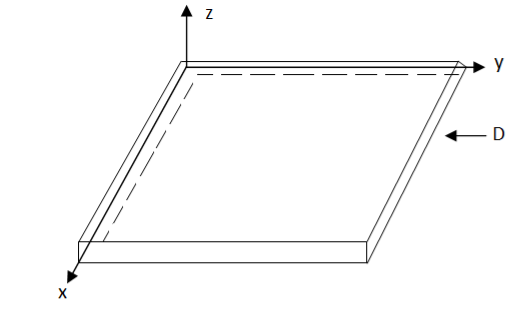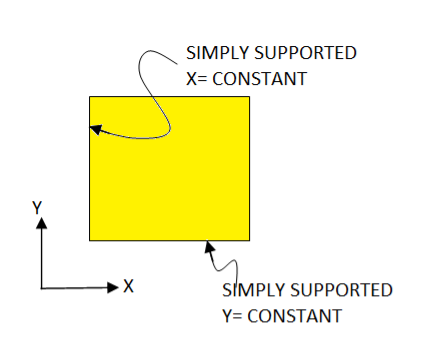UNIT 5
Introduction to Theory of Plates and Shells
Assumptions-
● Thickness is smaller than the other dimension.
● Displacements are much smaller than plate thickness.
● Governing equations are based on undeformed geometry.
● Materials follow Hook’s Law.
● The middle surface is always unstrained during bending.
● The Plane normal to the middle surface remains normal.
● Rotatory inertia is negligible. Transverse shear strains also negligible.
Let us consider a thin plate in xy plane as given in the figure-
|
Figure 5.1 A thin plate
Moments-
Moment wrt to y-axis- let us consider a cubical small element as shown in figure we will get
|
Figure 5.2 Small differential element
dFxx =σxx dz
Moment wrt to x-axis- (similarly)-
Twisting moment of shear stress
Using the section module formula of the beam –
|
Shear forces
Vertical equilibrium of plate-
Substituting the above equation we get-
Shear force according to thickness-
|
Governing Equation
For Qx –
|
Bi-harmonic governing equation
There are three possibilities of boundary condition-
- Simply supported-
|
Figure 5.3- Middle plane
For x constant –
w( x , y ) = 0


For edge y constant-
W=0


2. Clamped-
For x constant –
W=0

For y constant-
W=0

3. Free edge-
For x constant-
Bending moment-

Moment xy and shear –


For y constant-
Bending moment-
 =0
=0
Shear force-

5.3 Navier’s method for a simply supported rectangular plate
Navier solution for lateral deflection of a simply supported rectangular plate having dimension a and b with distributed q as shown in the figure-
|
Figure 5.4- Simply supported plate
Where m, n=1,3,5……
Multiply both side by sin(jπx/a) sin(kπy/b) and integrate wrt x and y from 0 to a
and 0 to b- Integrating wrt x-
Integrating wrt y-
At m = j
= Similarly at n=k –
Now the equation(1) will be –
Substituting w and q(x,y) in the fourth-order governing differential equation-
Now the W-
Integrating equation (2) wrt x and y-
And
Substituting the above two values in the equation number (2) we will get-
Now the equation (1) will be –
|
This is the equation of deflection for UDL using the Navier method for method.
5.4 Levy’s Method of Solution for Rectangular Plates
Let us consider a thin plate in xy plane in which at y=0 and y=b are simply supported and at x=0 and x=a can have any support like(clapped, free or simply supported) as shown in the figure –
|
Figure 5.5- Neutral plane of thin plate
A suitable governing equation for this case will be-
For an isotropic plate-
Let us consider this is a square plate a=b=1m, n=1 made of steel and n=1 then-
Because it is a differential equation of fourth-order. Hence it will give two solution-
Where λ is the roots of the equation.
If
For isotropic plate r12 = π2, now the roots will be- and
The solution-
And
The final solution will be-
|
The above equation is the solution for the plate using the Levy theorem.
Key Takeaway:
- KCPT
2. 3. 4. 5.
|
6. Navier Method For plate (deflection)
|
7. Levy theorem For plate
|
REFERENCES-
- Book- Mechanics by Fridtjov Irignes Chapter-7
- Sadd 9.3, Timoshenko Chapter-11
- Module 9 version 2 ME, IIT Kharagpur
- Book- solid mechanics- 2nd by Kelly





































































